On the morning of the fourth day of our French trip, I was both apprehensive and excited. The main reason we came to Normandy was to tour the D-Day beaches. The history geek in me had been waiting for this day in great anticipation. Before the trip, I read what I consider the best book on the subject, “The Longest Day” by Cornelius Ryan, and couldn't wait to start exploring the D-Day sights. At the same time, exploring this area where so many lives were lost was going to be hard. We were visiting around a special time: the U.S. Memorial Day weekend and just days from the 75th anniversary of D-Day.
To see this place properly, we purchased a semi-private excursion with Bayeux Shuttle. Although we had to pay $250, the tour was worth every penny. Touring all five D-Day beaches in a single day wasn't possible, and we focused on the American sector (Utah Beach, Pointe du Hoc, Omaha Beach, and two towns liberated by U.S. troops). All in all, the trip exceeded our expectations, and in the future, we plan on returning and touring the U.K. section (Sword Beach and Gold Beach), the Canadian section (Juno Beach), as well as other surrounding sights and museums.
The meeting point was near the Bayeux Cathedral in the city center. Our group of twelve was a mix of American families and couples with an interest in military history. Immediately, I felt a close bond with these strangers who would take a day out of their French vacations to learn about one of the most crucial operations in World War II. The guide assigned to our group was a bookish guy in his early 30s named Scott, who told us he was so fascinated with D-Day history that he moved to Normandy from his native Wales several years prior and stayed.
The weather wasn't pleasant. It drizzled the entire morning and most of the day. Usually, we wouldn't be thrilled with such conditions, but for this particular tour, the conditions were perfect as they were close to those that the Allied forces had to deal with during the invasion on June 6, 1944.
After everyone boarded a minibus, we left Bayeux for the first stop—Sainte-Marie-du-Mont. As we rode in gloomy and rainy weather, we passed a war cemetery with rows of solemn black German crosses. Scott told us that despite Germany losing the battle and being on the wrong side of history in the war, relatives of German soldiers still visit the cemetery as a place of remembrance. Later in the day, with the sun out and brightly shining, we visited the American war cemetery by Omaha Beach with perfect rows of glowing white crosses and Stars of David. The symbolism wasn't lost on us with the colors of tombstones and the weather conditions that day clearly contrasting the opposing sides of the war.
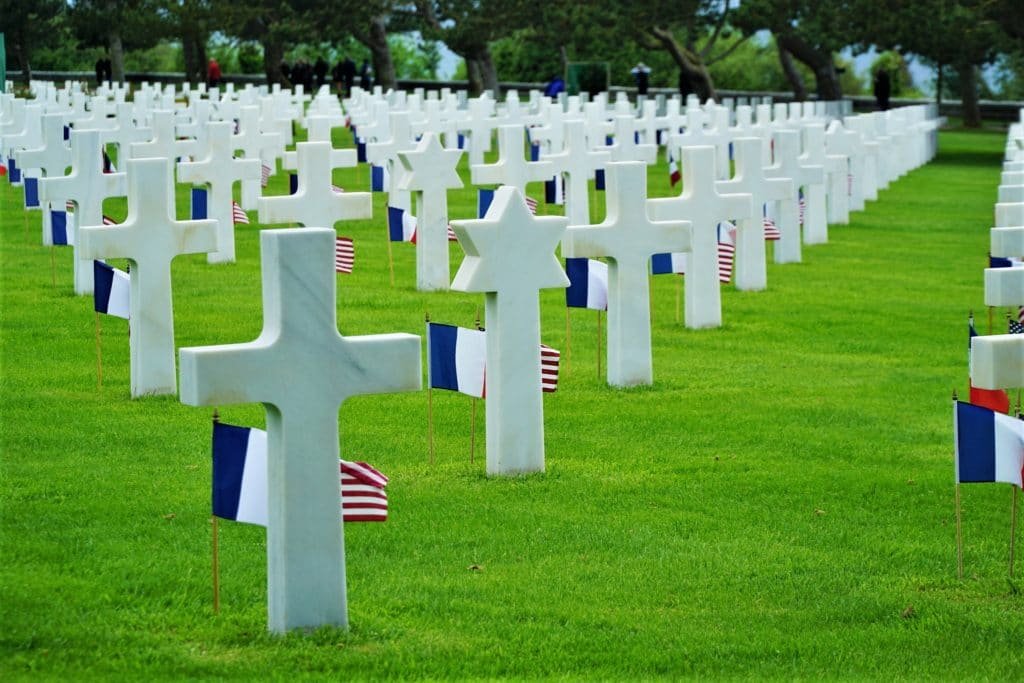
On the way to Sainte-Marie-du-Mont, Scott narrated the start of the operation. Just hours before the naval attack on the beaches began, paratroopers of the 101st and 82nd Airborne divisions were dropped off from the sky. Due to poor weather, most paratroopers missed their marks and were scattered throughout the Norman countryside. The Germans, fearing an invasion, had intentionally flooded the surrounding swampy fields that we were now passing in the minibus, and many soldiers drowned in these flooded plains. Those who didn't perish were hopelessly disoriented and couldn't immediately connect with people in their groups. As one commander later recalled, once he landed and couldn't find his men, he quickly realized that he could only give commands to the cows that surrounded him.
Sainte-Marie-du-Mont is a small French town with a typical Gothic cathedral and a monument commemorating D-Day events. Just three miles from the nearby Utah Beach, it had strategic importance, securing a safe passage for the troops invading from the sea. Standing by the cathedral walls, Scott described the fight to capture the town and how the paratroopers secured it before the invasion from the sea began at dawn. Inside the cathedral, bullet holes provided vivid evidence of the fighting.
We then drove to Utah Beach. The place is incredible as it has barely changed in the last 75 years. It looked very peaceful and serene, with fishermen harvesting oysters in the distance. Scott pointed out that initially, U.S. troops were supposed to land not here but hundreds of yards west, but the mistake was a happy accident that made Utah Beach the most successful and the least bloody. Unlike Omaha, Utah Beach doesn't have a tall bluff and wasn't heavily defended. With very limited casualties, U.S. troops landed here and practically marched onto the continent.
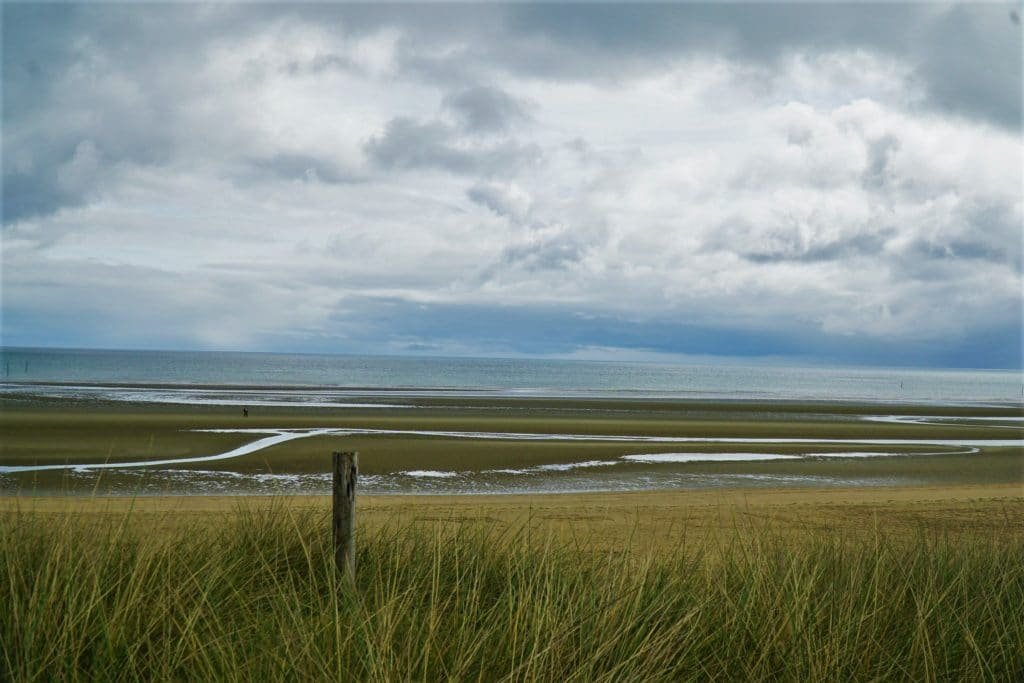
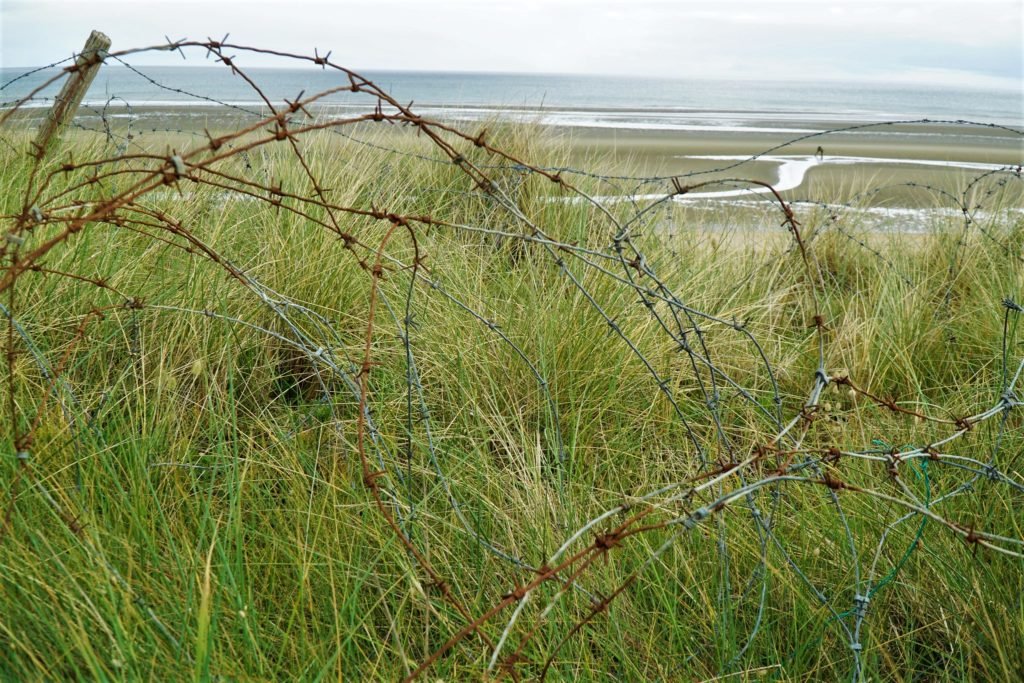
Driving back inland, we soon reached another town, Sainte-Mère-Église. Like Sainte-Marie-du-Mont, it was liberated by the U.S. hours before the start of the attack from the sea. Standing in the center of the town’s square, Scott’s eyes lit up, and he excitedly, as if he was doing it for the first time, described the events that took place here at midnight on June 6, 1944.
That night, one of the barns caught fire after an incendiary bomb had been airdropped on it, and all residents were out trying to put it out. German soldiers kept the situation under control as all of a sudden, U.S. paratroopers started to drop from the dark sky into the town’s square. The barn, fully engulfed in flames, illuminated the landing paratroopers, making them easy targets for the startled Germans. Some landed in the canopies of nearby trees that still stand today and were immediately shot.
One paratrooper, Private John Marvin Steele, was knocked unconscious when he hit the roof of the church with his parachute, tangling up in the church’s steeple. Steele's limp, motionless body was dangling from the steeple, and the Germans didn't even bother to shoot him as he looked very much dead. He was taken off the steeple hours later and made a prisoner. Steele later escaped from captivity and went to fight the war to the end, becoming an honorary citizen of Sainte-Mère-Église after the war and regularly visiting the town until he died in 1969. An effigy of Steele tied to a parachute now hangs from the church steeple, providing a daily reminder of the U.S. troops' sacrifice to liberate the town. Inside, the church is adorned with colorful stained glass windows depicting the Virgin Mary, who is surrounded not by Biblical angels but by American paratroopers descending from the sky.
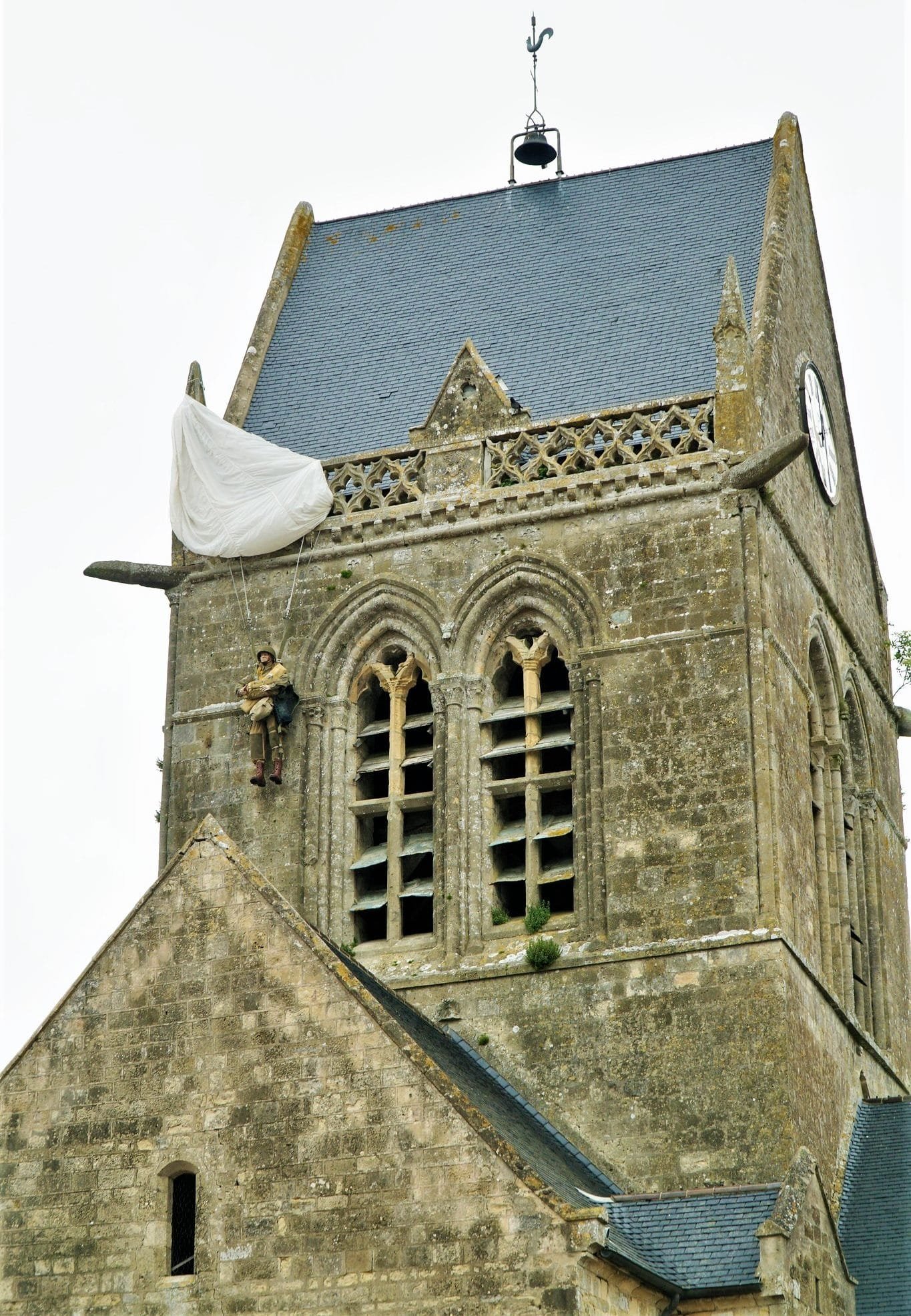

After a quick lunch and strolling around the square, we boarded our mini-bus to ride back to the coast, to the famous landing spot—Pointe du Hoc. Atop the cliffs overlooking the English Channel, we saw a landscape with deep craters from heavy artillery shelling that resembled the Moon's surface. The cold winds were hitting us in the face, but this uncomfortable weather was nothing in comparison to what U.S. Rangers faced here 75 years ago. We gathered around Scott, who detailed U.S. soldiers’ heroic actions of scaling and taking these 100-foot vertical cliffs, seizing the enemy artillery, and then defending these positions for days. As we stood on the edge of Europe, by the monument in the form of an oversized Ranger knife atop a concrete bunker, I was never prouder to be an American.
Omaha Beach, which we visited next, was the bloodiest of all five beaches on D-Day. A tall bluff overlooking the beach provided a clear advantage to the defending Germans as they could shoot the invading troops point-blank from a higher point. The beach was also full of mines and defensive fortifications that made any advancement extremely difficult. Referring to U.S. troops as “our boys” throughout the day in his slight Welsh accent, Scott described the heroism of U.S. servicemen at Omaha. We just stood there silently and listened to him talk about the disastrous start of the naval operation and how the first waves of the invading troops were slaughtered, but kept pushing forward.
“There are two kinds of people who are staying on this beach: those who are dead and those who are going to die.”
This phrase belongs to Colonel George Taylor, who rallied his troops at Omaha, trying to get them off the beach as soon as possible. Nearly 2,000 American lives were lost here on June 6, 1944, but by the evening, the beach was secured, and the liberation of Europe carried on. Omaha Beach is a truly profound place.
We finished the day by visiting the American war cemetery overlooking Omaha Beach with thousands of neat rows of white crosses. Some parts of the cemetery were closed in preparation for the 75th anniversary celebrations, but we had plenty of ground to cover, walking around and reading the names of soldiers laid to rest here. The U.S. flag was honorably lowered and folded at a daily sunset ceremony, which was a fitting conclusion to our trip to Normandy and the start of our journey back home.

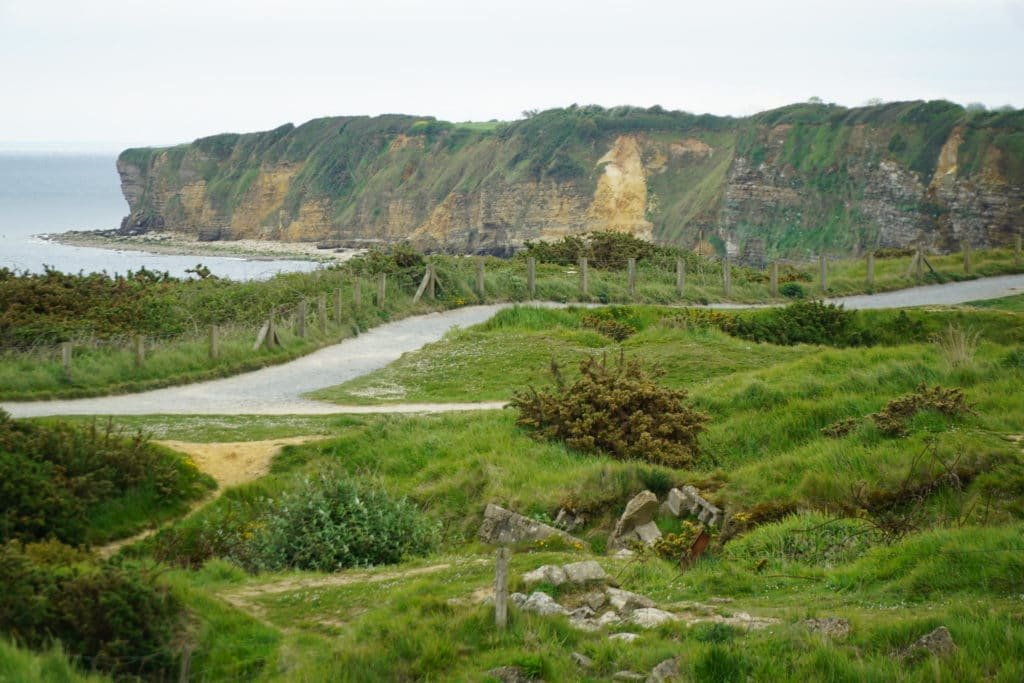

I’ve read books and watched movies about World War II, I studied the topic in school, and saw black-and-white photographs. And then I stood there, under the same drizzling rain on the heavy sand of the beach with waves crashing on the shore, imagining military boats in the fog and soldiers coming out of the water, as they did 75 years ago. It's a feeling like no other, suddenly being physically connected to a day in history, to a place in time, to understand in an intimate way the number of lives lost, the sacrifices made, and the victory against all odds.

